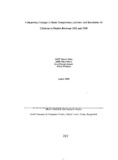Comparing changes in basic competency, literacy and enrolment of children in Matlab between 1992 and 1995
Citation
Rana, A. M., Chowdhury, A., Ahmed, S. M., & Bhuiyan, A. (2000, August). Combating a deadly menace: early experiences with a community-based arsenic mitigation project in Bangladesh. Research Reports (2000): Social Studies, Vol – XXVI, 207–235.Abstract
In 1995, three year after the baseline survey and initiation of the BRAC-ICDDR'B Joint
Research Project in Matlab, a follow up survey was carried out to explore changes in the
areas of education. These included enrolment, literacy and basic competency of children.
A total of 1703 children took part in the test in 1995. Of these 315 were from BRAC
households, 670 from eligible non-members and the other 718 from non-eligible
households. The children selected were between 11 to 15 years irrespective of whether
they enrolled in the school or not. The results showed improvement in each of the above
areas since 1992. Literacy as measured through verbal reporting, increased from 34.4 %
to 43.8% and was more noticeable among from BRAC organised households (p<.05).
Enrolment of children has increased significantly more in case of girls and the lesser
poor. The BRAC schools set up in the area in this time played an important role in these
changes. This is true particularly for girls who constitute about 70% of BRAC school's
enrolment.
The percentage of children qualifying for basic competency increased from 18% in 1992
to 26% in 1995. The rate of increase was almost equal for boys and girls but was higher
for the 'less poor' than the poorest children. Children belonging to the BRAC schools
performed much better than those in the government primary schools. The improvement
was minimal in villages where there was no school at all.

